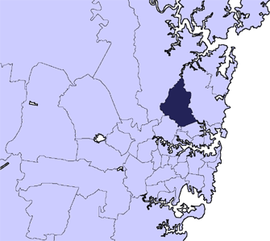
Back Ku-ring-gai CEB Ku-ring-gai Council German Conseil de Ku-ring-gai French Dewan Ku-ring-gai ID Municipalità di Ku-Ring-Gai Italian クー=リン=ガイ・カウンシル Japanese Ku-ring-gai Council Dutch Ku-ring-gai Polish Ku-ring-gai Swedish کو-رنگ-گائی کونسل Urdu
| Ku-ring-gai Council New South Wales | |||||||||||||||
|---|---|---|---|---|---|---|---|---|---|---|---|---|---|---|---|
 Location in Metropolitan Sydney | |||||||||||||||
 | |||||||||||||||
| Coordinates | 33°45′15″S 151°09′06″E / 33.75417°S 151.15167°E | ||||||||||||||
| Population | 126,983 (ERP[a] 2023)[1] | ||||||||||||||
| • Density | 1,486/km2 (3,850/sq mi) [1] | ||||||||||||||
| Established |
| ||||||||||||||
| Area | 85.44 square kilometres (32.99 sq mi)[1] | ||||||||||||||
| Mayor | Christine Kay (Independent Liberal) | ||||||||||||||
| Council seat | Gordon | ||||||||||||||
| Region | Metropolitan Sydney | ||||||||||||||
| State electorate(s) | |||||||||||||||
| Federal division(s) | Bradfield | ||||||||||||||
 | |||||||||||||||
| Website | Ku-ring-gai Council | ||||||||||||||
| |||||||||||||||
Ku-ring-gai Council is a local government area in Northern Sydney (Upper North Shore), in the state of New South Wales, Australia. The area is named after a fictional Aboriginal language group.[2][3][4]
Major transport routes through the area include the Pacific Highway and North Shore railway line. Because of its good soils and elevated position as part of the Hornsby Plateau, Ku-ring-gai was originally covered by a large area of dry sclerophyll forest, parts of which still remain and form a component of the Ku-ring-gai Chase National Park. There are also many domestic gardens in the residential parts of Ku-ring-gai.
The Mayor of Ku-ring-gai Council is Cr. Christine Kay, an Independent Liberal politician, elected from amongst her follow councillors in November 2024.
The council comprises an area of 86 square kilometres (33 sq mi), and as at the 2021 census, had an estimated population of 124,076. Ku-ring-gai is the most advantaged area in Australia to live in, at the top of the Index of Relative Socio-economic Advantage and Disadvantage (IRSAD).[5]
Cite error: There are <ref group=lower-alpha> tags or {{efn}} templates on this page, but the references will not show without a {{reflist|group=lower-alpha}} template or {{notelist}} template (see the help page).
- ^ a b c "Ku-ring-gai Council | Community Profile". profile.id.com.au. Retrieved 4 January 2025.
- ^ Attenbrow, Val (2002). Sydney's Aboriginal past: investigating the archaeological and historical records. Sydney: UNSW Press. pp. 22–35. ISBN 9781742231167.
- ^ Filling A Void: A review of the historical context for the use of the word 'Guringai'. Sydney: Aboriginal Heritage Office. 2015.
- ^ John, Morecombe (20 February 2015). "Misunderstanding: The historical fiction of the word Guringai that has filled a void in our knowledge of the original inhabitants". Manly Daily. Retrieved 23 September 2021.
- ^ Gladstone, Nigel (27 March 2018). "Sydney's latte line exposes a city divided". The Sydney Morning Herald. Retrieved 28 March 2018.